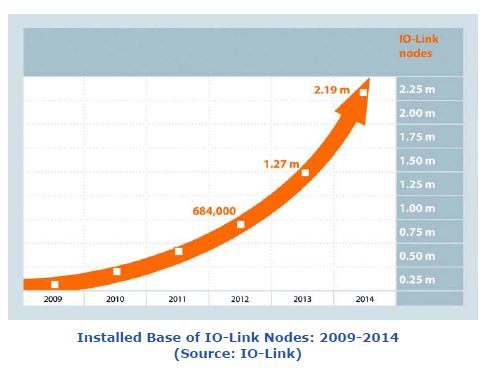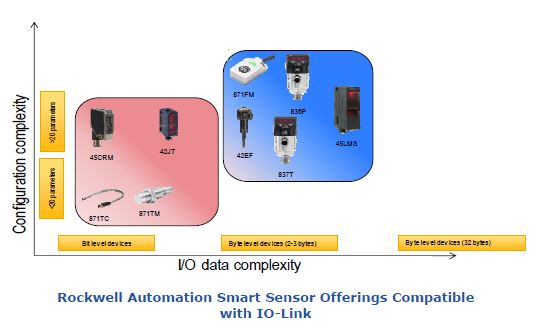Summary
Smart sensors are the front line in the Industrial Internet of Things (IIoT). In the process industries, intelligent field devices are now the norm, even if end users don’t always use the available diagnostic information. In the discrete manufacturing industries; smart sensors with self-diagnostic and digital network capabilities are addressing key end user requirements to reduce maintenance, increase overall equipment effectiveness (OEE), and digitally capture the knowledge of a rapidly shrinking skilled workforce.
All this is leading to a new generation of smart machines and represents a major step in the journey to IIoT-enabled operational excellence. But just implementing smart sensors is not enough. The information provided by these sensors must get to the right people, at the right time, and in the right context. This where the distinction between smart sensors and a smart sensing strategy comes into play. For smart sensing, network technologies can be of equal or greater importance than the smart sensor itself. Recently, ARC analysts met with executives from Rockwell Automation to examine some of the issues surrounding smart sensing and get an update on that company’s smart sensing strategy, including both smart sensors and the IO-Link digital network.
What’s Driving the Age of Smart Machines?
End users want smarter machines for several reasons, including the shortage of qualified personnel. With the exodus of experienced workers, much of the operational, procedural, and maintenance knowledge required to operate machines effectively is departing. Smart sensors offer a path to the digital capture of knowledge that can be used to reduce the need for preventive or reactive maintenance.
What Does the Installed Base of Smart Sensors Look Like Today?
Although all machines could benefit from smart sensors, most sensors on an average machine are still conventional. According to a recent ARC survey, around 25 percent of the sensors on today’s machines are typically smart, with the balance being analog sensors that may become dirty due to local cutting operations and/or require re-teaching to support tool changes.
The Difference Between Smart Sensors and Smart SensingApplying smart sensors alone isn’t enough. End users should also develop a strategy to turn the smart sensor data into useful information. By combining the different information provided by the smart sensors installed on a machine creates a smart asset. Often, the smart sensors themselves can incorporate human knowledge gained over several decades of machine operation.
Integration Supports In-context Information
Tight integration between the sensor and the control platform can add significant value to machine performance by providing the operator with contextualized information without requiring additional programming or customization. For example, damaged sensors needing replacement can be immediately displayed on the local HMI along with location information. Machine warnings detected by the sensors can be displayed based on the operator’s preference.
Soft Sensors
In addition to accessing both the measured variable and self-diagnostic information about the overall health of the sensor, the user can adjust parameter values and take advantage of features like automatic detection and recognition of new sensors on the network.
Inferential measurements can also be made between networks of sensors that combine and correlate information related to the manufacturing process and the condition of the machine. For example, a temperature sensor working with a vibration sensor can create a “soft” sensor to detect mechanical failure. The ability to take large volumes of data from large numbers of smart sensors and machines is essential for developing predictive algorithms that can identify potential future downtime incidents and increase overall equipment effectiveness (OEE). Both soft inferential sensors and hard sensors will need to work together.
OEM Machine Builders Benefit Too
Machine builders also benefit from smart sensors. For example, since sensor parameters can be adjusted by the controller, the effort needed to make tool/line changes is reduced. With the conventional method, the operator must remember how and which sensors to re-teach on the machine, depending on the product being made. This can take minutes or even hours. With smart sensors, it takes seconds. Using the controller to adjust sensor parameters also improves consistency in machine performance because the same values are used.
Ethernet Connectivity
Ultimately, the success of smart sensors will rely on making them transparent to the Ethernet-based open networks that provide the backbone for the new generation of intelligent machines. Use of standard Ethernet networking technology provides a greater choice of industry standard hardware components. Standardization facilitates the flow of information throughout the system. Data formatting, naming, and prioritizing and viewing diagnostic information all become easier.
Rockwell Automation’s Smart Sensor Strategy Rockwell Automation recently sat down with ARC analysts to discuss the strategy for smart sensing as it relates to the company’s vision of The Connected Enterprise. The company offers a wide range of smart discrete sensors and related products designed to help create a smart sensing strategy, from IO-Link Masters to IO-Link- and Ethernet/ IP-compatible ControlLogix PACs. To enable The Connected Enterprise, Rockwell Automation supports industry-standard networks, Ethernet technology, and integration of sensor information with the control and HMI infrastructure. This provides a contextual path for information throughout the manufacturing enterprise.
Rockwell Automation recently sat down with ARC analysts to discuss the strategy for smart sensing as it relates to the company’s vision of The Connected Enterprise. The company offers a wide range of smart discrete sensors and related products designed to help create a smart sensing strategy, from IO-Link Masters to IO-Link- and Ethernet/ IP-compatible ControlLogix PACs. To enable The Connected Enterprise, Rockwell Automation supports industry-standard networks, Ethernet technology, and integration of sensor information with the control and HMI infrastructure. This provides a contextual path for information throughout the manufacturing enterprise.
IO-Link Support
Rockwell Automation has a wide range of Allen-Bradley discrete sensors and IO-Link masters that support industry-standard IO-Link technology. IO-Link has been adopted as an international standard (IEC 61131-9). It is a low-cost, point-to-point wired sensor network that offers improvements in deployment, continuous operation, and diagnostics for the most widely used types of sensors. This includes photoelectric, inductive, and ultrasonic sensors. This open standard, available to all, is used by a majority of suppliers in both the sensor and automation markets.
Machines that require the sensor settings to be changed when the machine setup is changed to run a different package/product can benefit from IO-Link. With IO-Link, the sensor configuration values can be changed in seconds as these values can be stored in the PLC and downloaded to the sensor. This would be accomplished by selecting the appropriate recipe/profile from the HMI. Without IO-Link, this process could take up to 30 minutes as the operator physically re-teaches each of the sensors on the machine for the new product/package.
Seamless Integration with Ethernet/IP
Since Rockwell Automation offers a wide range of IO-Link Sensors, IO-Link Masters, and connectivity at the controller layer, the company can provide a seamlessly integrated solution with information from IO-Link visible on standard Ethernet/IP networks. In addition to making sensor data visible on Ethernet/IP, this also provides access to I/O and configuration data, simplifying parameterization and configuration.

IO-Link also offers several other advantages, such as compatibility with industry-standard cabling. IO-Link masters and devices can be added where the user can gain the most benefit from diagnostic and real- time health information. With IO-Link, the same sensor can be used in a discrete and/or smart application with the same sensor/cable catalog number. The only thing that would change for a smart sensor application is that the sensor connects to an IO-Link master, instead of a discrete input card.
Smart sensors from suppliers like Rockwell Automation can provide important information that can help improve OEE. This includes information that can help users avoid unplanned downtime, such as jam conditions; notification of dirty photoelectric lenses; and proximity alarms. Many smart sensors can also monitor their own internal temperature. This allows the end user to look for potential “hot spots” on their machines.
Conclusion
With the emerging Industrial Internet of Things (IIoT), many end users and OEMs are rediscovering the value of smart sensors for discrete applications. ARC recommends that end users move beyond simple adoption of smart sensors and consider an overall smart sensing strategy in which smart sensor data is turned into useful information to improve OEE, reduce unplanned downtime, and reduce ongoing maintenance costs. Rockwell Automation’s The Connected Enterprise strategy focuses on just this issue by integrating smart sensor information to enable connected and intelligent machines.
Embracing industry-standard networks should be part of any automation supplier’s IIoT or smart sensing strategy. Rockwell Automation’s adoption of IO-Link, in addition to its longstanding support of Ethernet/IP, means that end users can access a wide range of products that conform to industry standards supported by a large pool of automation suppliers and end user organizations.
Smart sensors, in conjunction with a smart sensing strategy and industry-standard networking, can enable companies to integrate large volumes of smart sensor data into an overall system architecture that can provide the right information to the right people at the right time and in the right format.
ARC Advisory Group clients can view the complete report at ARC Client Portal on Office 365 or Box.com
If you would like to buy this report or obtain information about how to become a client, please Contact Us
Keywords; Smart Discrete Sensors, Industrial Internet of Things (IIoT), Smart Machines, IO- Link, Ethernet/IP, Rockwell Automation, ARC Advisory Group.






